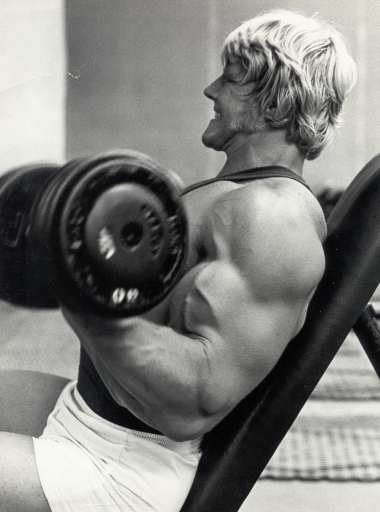Variations of the Curl

Download the full Draper here newsletter
in printable pdf format here.
How many bodybuilders does it take to train biceps and triceps?
One to find the bar, one to find the plates, one to find the collars, one to find the dumbbells, one to find the bench, one to find the fire extinguisher to put out the burn, one to find the compressor to get a good pump, one to count (good luck), and six to watch. That’s 14 strappin’ dudes, their girlfriends and two or three dogs.
How many exercises are there for biceps?
One. The curl.
How many variations of the curl?
V/C= DbxBbxAAxC>fb/ib/pb> or...a whole bunch.
Can you name at least 10 distinct variations of the curl and give us a brief description of your favorite?
Standing barbell curl
Dumbbell curl
Dumbbell alternate curl
Dumbbell incline curl
Flat bench curl
Reverse curl
Preacher curl
Hammer curl
Zottman curl
One arm concentration curl
Cable curls from creative positions with creative handles
Standing barbell curl: Were we to attach royal titles to this list of biceps-building movements, the standing barbell curl would be called “King.” There’s no exercise that does more for the subject than this standing curl performed with either a straight bar or a bar with grip-compatible bends.
Stand with the bar hanging comfortably before you, allowing your arms to fully extend. Breathe in and out healthfully several times as to oxygenate your system and ready yourself for the task. Pull the bar powerfully and steadily upward on an inhalation and draw the bar toward your shoulders; exhale as the resistance is at its critical peak and then, re-energized, pull harder. Reverse the direction of the bar upon completion, with care taken not to over-extend the motion and endanger the elbow joint or muscle insertions. Slowly lower the bar to the full, extended starting position and then repeat.
The upward pull of the bar is called the concentric action (the action of the weight away from gravity) and the downward motion is the eccentric action (the action of the weight toward the force of gravity).
The biceps are a relatively small muscle and undergo volumes of work as they assist in other exercises throughout a workout. Decide on a weight that allows you to complete three or four sets of 8 to 10 repetitions. A little body-action to assist the completion of the last reps can be a grateful benefit to the development of a mighty torso as well as thick, strong arms.
Once established in your biceps training, you may want to alter your tempo to a slower, more demanding count. Try two to three seconds up, a half-second pause and three for four seconds down. This adds up to a 5.5–7.5 second repetition or 45–75 second set. Mean and tough to do routinely, but works well from time to time if you’re bored, stressed, curious or injured.
The world famous Tilt-curl, named this very second by this floundering author is another variation of the barbell curl to remove tension from the long head of the bis and direct it to the biceps peak. In deference to the standard erect position, you would lean exactly five degrees forward and slowly curl the bar upward as if reaching toward the forehead. Contract with will and fight, slowly lower, extend and repeat. Dig in with each subsequent rep; the pump and burn are fierce.
Where there’s the standing forward Tilt-curl, there’s the standing backward Lean-curl. No, I’m not making a mockery of the King. This is serious stuff. Stand upright, bar hanging with a hip-wide grip; lean back comfortably. We don’t want to stress the lower back—we only seek to extend the biceps fully and direct the action to the lower belly of the muscle. Pull the bar with a dynamic exertion through its range of motion and again, slowly return with max focus on the lower biceps. This movement can happily be done with a lighter weight for control and surer, more definite reps. We’re not marble statues…thoughtful, meaningful body action is a-okay. Don’t knock yourself out.
You might experiment with a slight crouch and a bend at the waist to do a curl with the bar from its hanging position. The elbows can be leveraged against the knees or the bar can be left free and unencumbered and curled in a forward scoop-like fashion, an interesting version of the barbell curl to complete a biceps bombing routine. Killer isolated contraction.
We are not done with the big bad bar yet.
Straddle the end of your favorite flat bench with the bar in front of you to practice the seated rendering of the barbell curl. Grasp the bar in a grip just outside the thighs and pull the bar across the knees, your starting position.
I know you just got the big bad bar on your knees and it wasn’t easy and it seems like a dumb exercise anyway. You ready? Stabilize your body by extending your legs forward and pull the bar with all your might from the knee position to the shoulders and back to rest; pause, totally relax and take your next big breath. Boom. Hit it again.
Notice: Not just the biceps are flexing. The whole torso flares into contraction. Where’s that fire extinguisher when ya need it?
For literally decades, I mixed the standard barbell curl with the tilt and the lean variations within the same set to saturate the biceps’ potential output and protect them from overloading in any one particular groove.
Of course, all of these delights go best with a nice side of triceps.
Bomber
*****
Take a trip over to our
Musclebuilding Q&A Blog
... where Dave allows us a peek into his email outbox.
Did you sign up for Dave's expanded email yet?
It's free, motivating and priceless!
We'll also send you a link to Dave's free
Body Revival Tips and Hints e-report with your confirmation notice.

